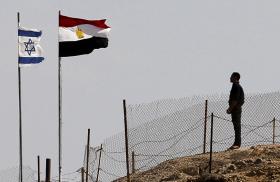For now, the Bush administration eschews the use of force while preparing for its use. But what will happen if a consensus develops that President Bush's diplomatic and economic approach is ineffective while a full-scale attack on Iraqi forces remains unattractive?
As an additional buildup of U.S. forces gets underway in the Gulf, senior military officials indicate that they are preparing a full range of options to present to President Bush within weeks. Is there a third option: the limited use of force in an "enhanced siege" strategy to raise the cost of Iraq's intransigence and give Baghdad an additional incentive to withdraw from Kuwait?
Defining a "Limited Force" Option
Under this strategy, U.S. Air Force and Navy aircraft would bomb targets in Iraq without any military action on the ground. The purpose of an enhanced siege strategy would be to avoid the immediate costs of a full-scale war while increasing the pressure on Saddam Hussein by use of American air power. This approach could upset Saddam's calculations about Iraq's ability to withstand sanctions, and increase Iraqi fears of an all-out assault.
If successful, a limited use of force would heighten tensions within Iraq and lead it to withdraw from Kuwait. Even if the enhanced siege did not achieve its political objectives, it could degrade Iraq's fighting capabilities and facilitate the success of a ground offensive against Iraq. The United States could attack such targets massively or gradually, based on its assessment of the most effective tactics.
There would be three types of potential bombing targets:
• Iraqi air defense and command, control, and communications assets. By eliminating these capabilities, U.S. forces would enjoy clear air superiority and would be able to operate virtually at will over Kuwait and southern Iraq.
• Key strategic and economic facilities whose destruction would make it difficult for Iraq to sustain its occupation of Kuwait. For example, destruction of Iraqi oil refineries would severely hamper Iraq's economy while destruction of water purification facilities in the south would make it extremely difficult for Iraq to sustain a long-term, large-scale military presence in Kuwait.
• Destruction of Iraqi chemical weapons and ammunition production facilities would also weaken that country's ability to fight or stage aggression.
Emergence of an Enhanced Siege Strategy
The idea of gradual escalation is undermined by the post-Vietnam U.S. military establishment's reflexive opposition to a concept of gradual escalation. Nonetheless, several factors could drive the Bush administration toward such a course. The situation in Kuwait is deteriorating seriously and, as President Bush has said, American patience is wearing thin. Already, half of Kuwait's citizens have left the country. While sanctions may eventually prove effective, they may be too late to save Kuwait.
Political pressures may also drive President Bush toward the use of limited force. America's Arab allies are reluctant to commit their own forces to an offensive action against Iraq. But they may be unable to maintain support for the anti-Iraqi coalition if Saddam Hussein appears to be succeeding in his efforts to outlast sanctions. Accordingly, some key Arab states are likely to argue for a U.S. offensive.
Yet a full-scale ground attack may produce unacceptably high casualties and an insufficiently quick or clear result. Although the United States is likely to continue its military buildup, it cannot achieve quantitative superiority over Iraq's 430,000 troops on the front, The United States could undertake an offensive despite numerical inferiority but untested U.S. troops might suffer heavy losses.
President Bush's coalition strategy might also dictate a limited use of force. UN Secretary-General Perez de Cuellar's recent endorsement of a military option as a last resort indicated that the UN Security Council could support such an approach. But it is difficult to imagine the Soviet Union and most European allies agreeing to an all-out assault against Iraq unless there is further Iraqi aggression or provocation.
Obstacles to an Enhanced Siege Strategy
While the United States may be pushed in the direction of an enhanced siege, many American military leaders will vigorously oppose it. The Vietnam War provided bitter experience with a gradual escalation approach. Gut instincts -- reinforced by recent American interventions in Grenada and Panama -- dictate that if the United States is to use force, it should do so massively, quickly, and decisively.
The enhanced siege strategy also has risks. While likely to limit near-term U.S. casualties, it would permit Saddam Hussein to plan an appropriate retaliation with the free use of his remaining military assets. While enhanced siege would strengthen the sanctions against Iraq, it is unclear whether it would be able to secure a speedy change in Iraqi policy. European and Arab allies might distance themselves from an American use of force which did not produce quick results. The American public might revolt against even limited U.S. casualties if a clear resolution to the crisis was not in sight.
For these reasons, an enhanced siege strategy appears less likely today than the approaches of negotiation, full-scale war, or the threat of such war to force Iraqi compliance with Security Council resolutions. If, however, the international community sticks to its objectives, if Iraq is unwilling to withdraw peacefully, and if the United States fears the casualties attendant with a ground assault on Iraq, a strategy of limited force may become more attractive.
Marvin Feuerwerger is the senior strategic fellow at The Washington Institute and the principal author of the 1991 study Restoring the Balance: An Interim Report of The Washington Institute's Strategic Study Group. He previously served as deputy assistant secretary for policy analysis at the Department of Defense.
Policy #22


